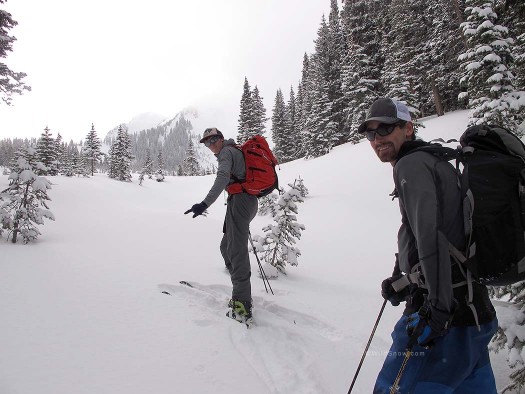This time of year, wishful predictions fly about snowfall for the coming ski touring season. For 2015-2016, scientific data may provide a more reliable forecast. The Los Angeles Times reports climatologists expect a Godzilla El Niño which could bring once-in-a-lifetime storms this winter.
For backcountry skiers, especially those in the Sierra and Rocky Mountains, those words create visions of champagne powder days — dreams of snorkel deep runs. While surfing bottomless fluff is blissful, breaking trail to get to the goods can be tough, especially when fresh snow accumulates on your skis. All of a sudden, your elegant one-kilo planks become lead two-by-fours.
Backcountry Access offers a solution. Their new Scepter pole has a scraper grip, designed to push snow off skis, eliminating drag on the up so you can fly on the down.
Snow stack 5 mm thick adds about a pound of weight to a pair of skis. By comparison, the added weight of the scraper grip is minimal, especially since BCA drilled out the grip in strategic places to make it as light as possible.
I took the Scepters with me to Norway last May. We missed a big powder storm by a week so I wasn’t able to use the grips to free my topsheets of deep flakes. But I found the flat top of the scraper handy to push off while climbing steep trails.
I prefer backcountry skiing without pole grip straps. Scepters come with removable straps. With straps gone, the scraper grip helps keep the pole in hand without having to grip it too tightly. The scraper also has a utility hook, nice for releasing your tech bindings or flipping heel lifters without bending over. The upper shaft is textured for nonslip grab.
Scepters are only available as adjustable backcountry skiing poles. To shave weight and for better swing, I prefer non-adjustable poles, especially since I don’t usually change pole length while I’m touring, but the adjustable Scepters are nicely balanced so perhaps the extra weight isn’t an issue. Still, I’ll trim a small amount off the lower shaft. Every gram helps!
Specifications:
BCA Scepter Carbon Alum
Shaft: Carbon upper, aluminum lower
Manufacturer stated weight: 8.3 oz/235 g (single pole)
Weight of my test pole: 8.8 oz/249 g (single pole, no strap)
Sizes: Adjustable 105 cm – 145 cm
Grip: BCA scraper grip, rubber overmold
Basket: BCA concave hex basket
Tip: Carbide
MSRP: $120 USD
BCA Scepter Aluminum
Shaft: Aluminum upper and lower
Manufacturer stated weight: 8.8 oz/250 g (single pole)
Sizes: Adjustable 105 – 145 cm
Grip: BCA scraper grip, rubber overmold
Basket: BCA concave hex basket
Tip: Carbide
MSRP: $80 USD
BCA Scepter 4s — four-piece collapsible shaft
Shaft: Aluminum
Manufacturer stated weight: 9.7 oz/275 g (single pole)
Sizes: Adjustable 110 cm – 130 cm, 40 cm collapsed
Grip: Grip sleeve but no scraper
Basket: Folding pole specific, nesting BCA concave hex basket for storage
Tip: Carbide
MSRP: $120 USD
WildSnow Girl, Lisa Dawson, is the luckiest girl in the world. Also known as Mrs. WildSnow.com, she tests whatever gear she wants. She gives the WildSnow family of websites the feminine voice.



